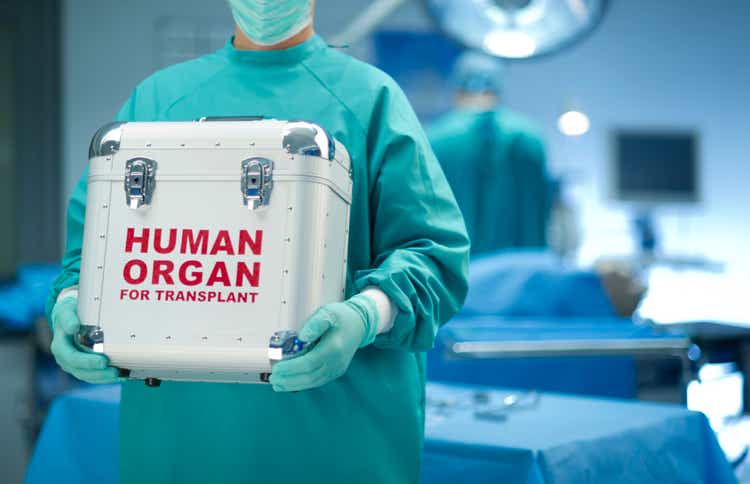sturti
Investment Thesis
CareDx, Inc. (NASDAQ:CDNA) reported lackluster revenue growth in its latest quarter, signaling that the intensifying competitive landscape in the organ transplant molecular diagnostics industry may be beginning to take a toll on the company’s growth trajectory. During the earnings call, management remained confident that its recent strategic initiatives will position it to compete effectively in a rapidly evolving market landscape. This article downgrades CDNA’s buy rating to hold based on weaker near-term revenue growth visibility but maintains a positive outlook on a strong balance sheet and low operating cash burn.
Revenue Trends
CDNA reported total revenue of $79.4 million during the third quarter, up $3.8 million (5%) year-over-year. The increase was primarily due to higher sales from the company’s digital solution business, adding $4.8 million to the topline figure compared to the same quarter of last year, supported by MedActionPlan and December 2021 acquisitions, adding some inorganic growth to the company’s digital services venture. Meanwhile, revenue from the company’s diagnostic solutions segment declined by $1.7 million (2.5%) year-over-year, while product testing kit sales remained relatively unchanged. To add insult to injury, operating costs increased 14%, exceeding the increase in revenue, while loss from operations nearly doubled from $8.7 to $17.3 million.
Shares fell by double-digit rates after the company reported its mediocre results last Thursday. The performance gap between CDNA and its peers continues to widen, with shares falling 11% today (November 10), despite the solid rally in the gene testing sector, with Invitae (NVTA), Guardant (GH), Veracyte (VCYT), 23andMe (ME), NeoGenomics (NEO), Myriad (MYGN) and SomaLogic (SLGC) delivering double-digit gains in intraday trading.
To understand CDNA’s ticker behavior, one must understand critical market dynamics currently impacting the gene testing market. In the past few quarters, institutional investors started demanding more straightforward profitability plans as capital costs rose along with interest rates. This sudden paradigm shift left gene diagnostic companies walking a thin line, balancing profitability with “essential” capital and operational expenditure to remain relevant, a challenging position, given the unique market structure, requiring significant spending on marketing, product awareness campaigns, and clinical studies to prove clinical validity. CDNA failed both on the revenue and profitability fronts.
CDNA’s testing volumes rose by 15% YoY and 3% sequentially, a decent quarterly increase. Management cited a higher commercial-payor mix for the revenue decline. Commercial payers, such as UnitedHealth (UNH) and Humana (HUM), have the resources to invest in medical audit operations. They can delay or deny claims if they deem the test unnecessary or overly expensive. An increasing number of Medicare enrollees are opting for Medicare Advantage “MA,” an alternative for Medicare beneficiaries to receive their Part A and Part B benefits through a private insurer instead of the traditional fee-for-service model provided by Original Medicare. Thus, the payer mix challenges experienced in Q3 will likely be around for a while, but more importantly, they carry competitive challenges.
CDNA is no longer the only game in town after Natera, Inc. (NTRA) introduced Prospera in September/October 2021. Although commercial payors are required to provide the actuarial equivalent of Original Medicare to their MA enrollees, the law doesn’t specify a brand. With the introduction of Prospera, commercial insurance companies have more bargaining power. Moreover, the company is expanding into areas structurally with lower medicare coverage. For example, Medicare’s (either Original or MA) share in the lung transplant market is significantly lower than that of Kidney and Heart.
The company is banking on several revenue drivers, including introducing new products, such as UroMap, expanding Medicare coverage of commercially-available products, such as AlloMap Kidney (currently under CMS review), and finally, investing in billing and collection operations. I am not convinced that these initiatives are enough to offset the intensifying competitive dynamics manifested in this quarter. I believe we are entering a new era in the organ transplant gene testing market, where CDNA is no longer the reigning queen.
Financial Position
The company ended the third quarter with cash and cash equivalents of $290 million, compared to $349 million as of December 2021 and $306 million in Q2 2022. The decrease in cash was primarily driven by operating cash outflows and capital expenditure incurred to build capacity and enhance product offerings. Nonetheless, the low cash burn metrics ($7 million in Q3) suggest that the company is conservative with its spending. For that, I believe that CDNA has a solid financial position, with adequate liquidity to fund its operations without the need to raise additional capital. The number of shares outstanding has remained relatively unchanged since 2020.
Looking ahead, I would anticipate further downside in the stock in the near term, given renewed growth uncertainty stemming from the emerging competition. Still, I would maintain the outlook on the stock as positive, given the long-term growth opportunity presented by the gene therapy field and the sustained strong financial position of the company. In terms of valuation, the stock decline has made CDNA slightly more attractive than some of its peers. Going forward, I would monitor CDNA’s cash position closely and would consider raising our price target if the firm manages to leverage operations into profitability.
Summary
CDNA released disappointing third-quarter results last week, warranting a rating downgrade. Core testing service revenue declined, while product revenue remained relatively flat. Total sales growth of 5% is largely attributable to recent acquisitions mirrored in its digital service segment.
Rising competitive pressure and expansion in market niches with lower Medicare coverage are impacting Average Test Prices. These dynamics will likely continue in the coming quarters, exacerbated by the increasingly adverse reimbursement environment as more seniors shift from Original Medicare to MA. Further improvements in CareDx’s profitability are necessary before I consider recommending a rating or price target raise.


Be the first to comment